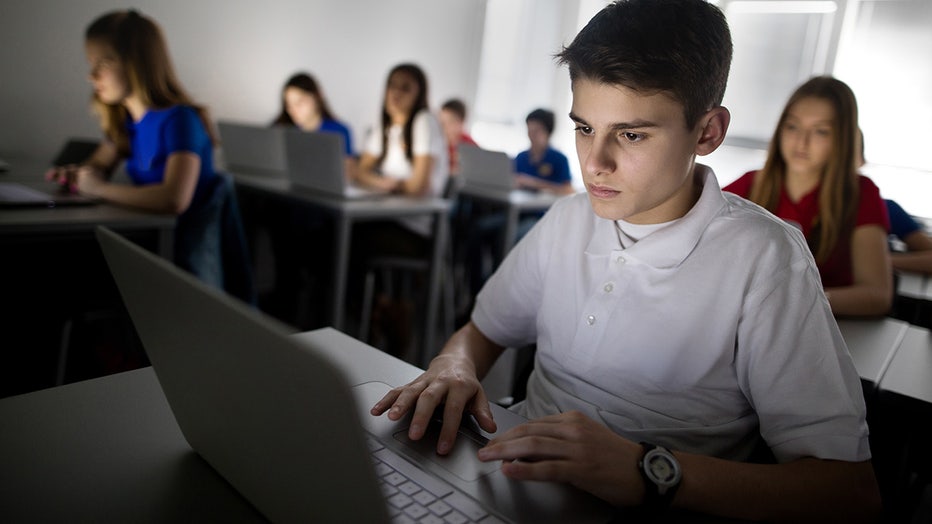SATs go digital this weekend: Here's what students think
SAT season has returned for thousands of high schoolers, but this year will be different. For the first time, there will be no "pencils down" for anyone – all students will be taking the standardized test digitally.
For many, it’s not a big leap. Technology in the classroom and remote learning – both accelerated by the COVID-19 pandemic – has become more commonplace, while teens and their phones are famously inseparable.
"Today's students, they do a lot of their living digitally, they do a lot of their learning digitally and they do a lot of their test taking digitally," Priscilla Rodriguez, who oversees the SAT for the College Board, recently told NPR.
How does the digital SAT work?
Some things are still the same. There are still two sections — one math, the other reading and writing — each worth up to 800 points.
But the digital test is an hour shorter. It adapts to students' performance, with questions becoming slightly easier or harder as they go. Each student is timed individually so breaks could come at slightly different times.
Test-takers can use their own laptops or tablets, but they still have to take the exam at a monitored testing site or in school, not at home. They must download the College Board’s Bluebook app to run the test. It includes a built-in advanced calculator for use during the exam.
To prevent cheating, students can’t work in any other program or application while the test is running.
Test proctors will collect students’ phones and other devices or direct students to leave them in their backpacks out of sight for the entire test, including breaks.
This is the first year all tests are going digital. International students took a digital-only version last year, while a digital-only PSAT was given to younger students last fall.

(File: BraunS / E+ via Getty Images)
What are students saying about the digital SAT?
Emerson Houser, 17, is taking the test on Saturday in Columbus, Ohio. Judging from her online practice tests, she told the AP that she prefers the digital version.
"We didn’t have to fill in the bubble sheet so we just had to focus on our screens the entire time," she said. "It made it easier to read the prompts and respond."
"I’ve always been the type to do things on paper, so at first I didn’t really like it, but it’s not terrible," Rachel Morrow, a junior at Holy Family Cristo Rey Catholic High School in Birmingham, told the AP. She likes a timer function that keeps her on track without having to watch the clock.
Holy Family Cristo Rey junior Ashley Chávez-Cruz said there are features that make the digital test feel familiar, like a highlighting option. But she said it's harder to mark up problems and passages because you can only make notes in the digital version in a text box off to the side.
Stephany Perez, a high school junior from Houston, told NPR that the transition to online is "not that significant."
"We're so used to being on our laptops, like it's something we do on the regular, in every class."
Digital SAT practice
The College Board says there are several ways students can practice for the new test. The Bluebook testing app contains full-length practice tests that are adaptive, like the real test will be. The app can also give test-takers practice using their device to make sure they are comfortable with the setup.
Pencil and paper are still good, at least for practice. Students can still download practice tests to print out and use offline, though they won't be adaptive the way the digital version is, and students must time themselves.
Colleges and the SAT
The COVID-19 pandemic had a significant impact on college testing and prep. A full testing season ended up being cancelled, while the debate intensified about whether the exams favor students from high-income families.
That led many colleges to drop test requirements, and today most still leave it up to students to decide whether to submit scores.
But recently, a small number of highly selective colleges, including Dartmouth and Brown, announced they would resume requiring SAT or ACT scores. According to the AP, they say the tests allow them to identify promising students who might otherwise be overlooked — students from schools that don't offer advanced coursework and extracurriculars, and whose teachers may be stretched too thin to write glowing letters of recommendation.
The College Board says about 1.9 million students in the class of 2023 took the SAT at least once, up from 1.7 million in 2022.
While the test is generally offered on Saturdays, more schools are setting aside an in-class day for testing. In the class of 2023, 67% of SAT takers took the test on a school day, compared to 63% of the class of 2022, and 62% of the class of 2021.
This story was reported from Tampa, Fla. Carolyn Thompson of The Associated Press and Rebecca Griesbach of AL.com contributed.

